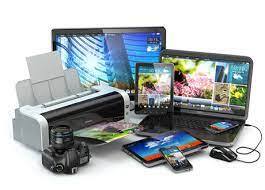 lectronics is a scientific and engineering discipline that studies and applies the principles of physics to design, create, and operate devices that manipulate electrons and other electrically charged particles. Electronics is a subfield of electrical engineering, but it differs from it in that it focuses on using active devices such as transistors, diodes, and integrated circuits to control and amplify the flow of electric current and to convert it from one form to another, such as from alternating current (AC) to direct current (DC) or from analog to digital. Electronics also encompasses the fields of microelectronics, nanoelectronics, optoelectronics, and quantum electronics, which deal with the fabrication and application of electronic devices at microscopic, nanoscopic, optical, and quantum scales.
lectronics is a scientific and engineering discipline that studies and applies the principles of physics to design, create, and operate devices that manipulate electrons and other electrically charged particles. Electronics is a subfield of electrical engineering, but it differs from it in that it focuses on using active devices such as transistors, diodes, and integrated circuits to control and amplify the flow of electric current and to convert it from one form to another, such as from alternating current (AC) to direct current (DC) or from analog to digital. Electronics also encompasses the fields of microelectronics, nanoelectronics, optoelectronics, and quantum electronics, which deal with the fabrication and application of electronic devices at microscopic, nanoscopic, optical, and quantum scales.
Electronics have a profound impact on various aspects of modern society and culture, such as communication, entertainment, education, health care, industry, and security. The main driving force behind the advancement of electronics is the semiconductor industry, which produces the basic materials and components for electronic devices and circuits. The semiconductor industry is one of the largest and most profitable sectors in the global economy, with annual revenues exceeding $481 billion in 2018. The electronics industry also encompasses other sectors that rely on electronic devices and systems, such as e-commerce, which generated over $29 trillion in online sales in 2017.
History and development[edit]

Electronics has hugely influenced the development of modern society. The identification of the electron in 1897, along with the subsequent invention of the vacuum tube which could amplify and rectify small electrical signals, inaugurated the field of electronics and the electron age.[1] Practical applications started with the invention of the diode by Ambrose Fleming and the triode by Lee De Forest in the early 1900s, which made the detection of small electrical voltages such as radio signals from a radio antenna possible with a non-mechanical device.
Vacuum tubes (thermionic valves) were the first active electronic components which controlled current flow by influencing the flow of individual electrons,[2] They were responsible for the electronics revolution of the first half of the twentieth century,[3][4] They enabled the construction of equipment that used current amplification and rectification to give us radio, television, radar, long-distance telephony and much more. The early growth of electronics was rapid, and by the 1920s, commercial radio broadcasting and communications were becoming widespread and electronic amplifiers were being used in such diverse applications as long-distance telephony and the music recording industry.